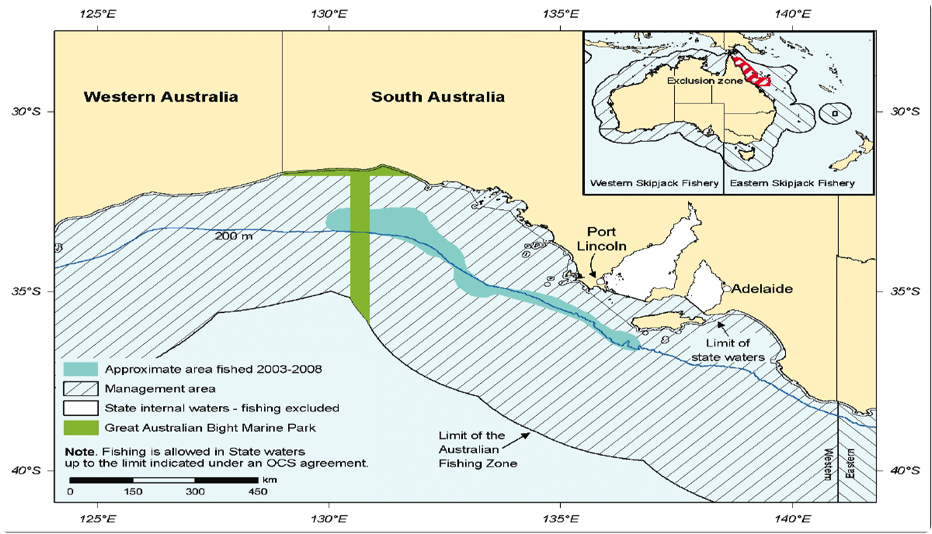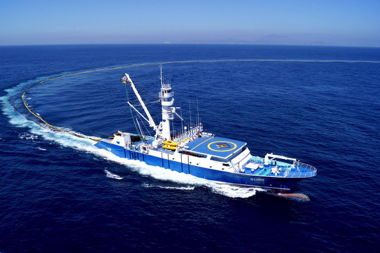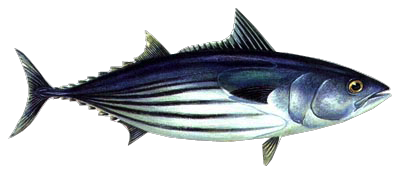AUSTRALIAN SKIPJACK TUNA FISHERY
The Australian Skipjack fishery is divided into two fisheries, the Eastern and Western.
The Eastern fishery extends from Cape York Peninsula (excluding the Great Barrier Reef Marine Park) to the South Australian/Victorian border.
The Western fishery extends westward from the South Australian/Victorian border across the Great Australian Bight, around the west coast of Western Australia to the Cape York Peninsula.
Skipjack distribution in the Australian Fishing Zone (AFZ) on the east coast is from far north Queensland to Tasmania; off southern Australia from Kangaroo Island in the Great Australian Bight, and up the west coast to Broome.
Principal Species
Skipjack tuna (Katsuwonus pelamis) is the only target species in the fishery.
FISHING TECHNIQUES
Historically the majority of the catch in the Skipjack fishery is taken by purse seine.
CONTROL OF THE FISHERY
Australia Fisheries Management Authority (AFMA) controls the Skipjack Fishery by
the issue of fishing permits. Regulations apply to net size only,
(no restriction to boat size) and quantity of by-catch.
NUMBER OF VESSELS / PERMITS
There are 13 Permits (Fishing licenses) in the Western Skipjack Tuna Fishery (WSTF).
QUOTA
There are no TACC limits set for the Western Skipjack Tuna Fishery (WSTF).
FISHING AREA:
Anywhere within the;
Australia 200-mile limit from Cape York extending westward around to the South Australian/Victorian border;
High seas of the Indian Ocean as per IOTC regulation.
FISHING SEASON:
No restrictions by AFMA, licensed to fish year round. Due to poor weather conditions, fishing season is limited to the Australian Summer period, December to March.
HISTORY - FISHING EFFORT
In recent years, there has been very little effort in the fishery:
Eastern Skipjack Tuna Fishery, no active vessels since 2006.
Western Skipjack Tuna Fishery, three vessels active in 2006, one vessel active in 2007, two vessels active in both 2008 and 2009.
There were no vessels active anywhere in the fishery in 2010-2013
HISTORY - CATCH
Catches for the Eastern and Western Skipjack Tuna Fisheries from 2006-2010 is shown in Table 1.
Table 1. Annual domestic catch of skipjack tuna in the Skipjack Tuna Fishery in kilograms (source: AFMA logbooks, in AFMA submission 2011).
Sub-fishery 2006 2007 2008 2009 2010 2011 2102 2013 to 2018
Eastern Skipjack 44,000 0 0 0 0 0 0 0 0
Western Skipjack 446,000 0 77,000 855,000 0 0 0 0 0
Total 490,000 0 77,000 855,000 0 0 0 0 0
Regionally, the estimated total catch of skipjack tuna in the Western and Central Pacific Ocean in 2010 was 1,706,166 tonnes, with an estimated total of 417,353 tonnes taken in the Indian Ocean.
HISTORY - MARKET
Historically Skipjack tuna taken in Australian waters was supplied almost exclusively to the cannery in Port Lincoln. This cannery closed in May 2010.
With no tuna canneries in Australia since 2010, there is no longer a domestic market for skipjack tuna.
STOCK STATUS
The fishery is not overfished, nor subject to overfishing, Western and Central Pacific Ocean Fisheries Commission (BRS, 2012).
FISHERY STATUS
Skipjack tuna (Katsuwonus pelamis) are not considered overfished in either the Western or Eastern Skipjack Tuna Fisheries (Marton et al, 2011).
There is no formal stock assessment of skipjack tuna in the Western Skipjack Tuna Fishery, due to very low effort by Australian vessels. Skipjack tuna is regarded as a highly productive species that is robust to fishing pressure (Marton et al, 2011).
BY-PRODUCT SPECIES
Bigeye tuna (Thunnus obesus), yellowfin tuna (Thunnus albacores) and mahi mahi (Coryphaena hippurus) are the main byproduct species caught in the Skipjack Tuna Fishery. In Australia there has been no byproduct or bycatch reported since 2008.
Take of bigeye and yellowfin tuna is limited to 2% of the total weight of a vessel’s seasonal skipjack tuna catch.
SEASON
There are no seasonal closures imposed on the Skipjack Tuna Fishery. The fishing season is managed by the financial year calendar.
MANAGEMENT ARRANGEMENTS
The Skipjack Tuna Fishery is managed by AFMA under the Fisheries Management Act 1991, through a permit system. Permits are issued to operators on an annual basis.
Management arrangements applied through permits include:
• limited entry;
• limited access to identified fishing zones;
• gear restrictions (purse seine only, with specified dimensions);
• restriction of target species;
• bycatch limits; and
• restrictions on fishing around Fish Aggregating Device (FAD).
There are currently no catch or effort limits for skipjack tuna as the resource is considered to be under-fished in Australian waters at current fishing levels.



SOUTHERN SKIPJACK TUNA FISHERY

